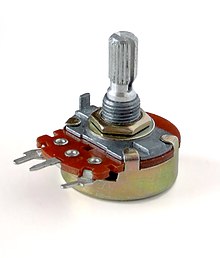Potentiometers

A typical single-turn potentiometer
|
|
| Type | Passive |
|---|---|
| Electronic symbol | |
|
|
|
A potentiometer, informally a pot, is a three-terminal resistor with a sliding or rotating contact that forms an adjustable voltage divider. If only two terminals are used, one end and the wiper, it acts as a variable resistor or rheostat.
The measuring instrument called a potentiometer is essentially a voltage divider used for measuring electric potential (voltage); the component is an implementation of the same principle, hence its name.
Potentiometers are commonly used to control electrical devices such as volume controls on audio equipment. Potentiometers operated by a mechanism can be used as position transducers, for example, in a joystick. Potentiometers are rarely used to directly control significant power (more than a watt), since the power dissipated in the potentiometer would be comparable to the power in the controlled load.
There are a number of terms in the electronics industry used to describe certain types of potentiometers:
Potentiometers consist of a resistive element, a sliding contact (wiper) that moves along the element, making good electrical contact with one part of it, electrical terminals at each end of the element, a mechanism that moves the wiper from one end to the other, and a housing containing the element and wiper.
See drawing. Many inexpensive potentiometers are constructed with a resistive element (B) formed into an arc of a circle usually a little less than a full turn and a wiper (C) sliding on this element when rotated, making electrical contact. The resistive element can be flat or angled. Each end of the resistive element is connected to a terminal (E, G) on the case. The wiper is connected to a third terminal (F), usually between the other two. On panel potentiometers, the wiper is usually the center terminal of three. For single-turn potentiometers, this wiper typically travels just under one revolution around the contact. The only point of ingress for contamination is the narrow space between the shaft and the housing it rotates in.
...
Wikipedia
